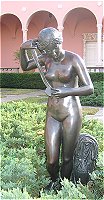Venus with Sword of MarsMuseum Label: Chiurazzi description: |
Hellenisric Art:
Hellenistic sculpture repeats the innovations of the second classicism: perfect
sculpture in the round, allowing the statue to be admired from all angles; study of
draping and effects of transparency of clothing; suppleness of poses. Thus, Venus, even
while echoing a classic model, is distinguished by the twist of her hips. One seeks, above
all, expressivity and atmosphere. This search is particularly flagrant in the portraits:
more than the precision of the traits represented, the artist seeks to represent the
character of his/her subject. In the great statuary, the artist explores themes such as
suffering, sleep or old age. One such is the Barberini Faun of Munich, representing a
sleeping satyr with relaxed posture and anxious face, perhaps the prey of nightmares.
Laoco n, strangled by snakes, tries desperately to loosen their grip without affording a
glance at his dying sons.
Pergamon did not distinguish itself with its architecture alone: it was also the seat of a
brilliant school of sculpture called Pergamene Baroque. The sculptors, imitating the
preceding centuries, portray painful moments rendered expressive with three-dimensional
compositions, often V-shaped, and anatomical hyper-realism.
Attalus I (269-197 BC), to commemorate his victory at Caicus against the Gauls —
called Galatians by the Greeks — had two series of votive groups sculpted: the first,
consecrated on the Acropolis of Pergamon, includes the famous Gaul killing himself and his
wife, of which the original is lost; the second group, offered to Athens, is composed of
small bronzes of Greeks, Amazons, gods and giants, Persians and Gauls. Artemis Rospigliosi
of the Louvre is probably a copy of one of them; as for copies of the Dying Gaul, they
were very numerous in the Roman period. The expression of sentiments, the forcefulness of
details — bushy hair and moustaches here — and the violence of the movements are
characteristic of the Pergamene style.
These characteristics are pushed to their peak in the friezes of the Great Altar of
Pergamon, decorated under the order of Eumenes II (197-159 BC) with a gigantomachy
stretching some350 ft in length, illustrating in the stone a poem composed
especially for the court. The Olympians triumph in it, each on his side, over Giants most
of which are transformed into savage beasts: serpents, birds of prey, lions or bulls.
Their mother Gaia, come to their aid, can do nothing and must watch them twist in pain
under the blows of the gods.
Another phenomenon appears in Hellenistic sculpture: privatization, which involves the
recapture of older public patterns in decorative sculpture. This type of retrospective
style also exists in ceramics. As for the portaits, they are tinged with naturalism, under
the influence of Roman art.
Venus:
Venus was an Italian fertility goddess, especially the protectress of gardens. Later she
was identified with Aphrodite, whose myths she appropriated, and her consort was Mars
(although her husband in myth was Vulcan). As mother of Aeneas she became much more
important in Roman mythology, a process that culminated in the dedication (A.D. 121) of a
temple to Venus Felix ("Bringer of Success") and Roma Aeterna ("Eternal
Rome") by the emperor Hadrian. As Venus Cloacina she had a shrine in the Forum beside
the drainage system of the area (called the Cloaca); Pompey dedicated a temple to her as
Venus Victrix ("Conqueror") as part of his theater, the first permanent stone
theater at Rome (55 B.C.). Julius Ceasar (46 B.C.) dedicated a temple to her as Venus
Genetrix ("Ancestress"), honoring her as the founder of his family, The gens
Iulia. Her first temple at Rome (215 B.C.) was that of Venus Erycina in Sicily.
